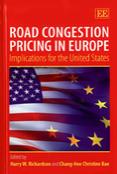fragile territories social capital urbanism digitalization dottorati design scenarios innovation simulation local development immigration land use regulation globalization information technology urban policies landscape città storica urban design creativity conservation & preservation spatial planning public art open spaces downtowns
Road Congestion Pricing in Europe. Implications for the United States - Review
by Paolo Beria
The book, edited by Richardson and Bae, includes contributions of some of the most recognised scholars in the field of transport economy. Despite the fact that is a collective work, the topic is discussed in a fairly unitary way, without significant superimpositions among chapters. At the same time the book shows an excellent completeness, especially when pointing out the most advanced and debated issues and applications. Only the basics principles of charging are missing, but this lack is not problematic, since the topic is supposed to be well known among the specialists interested to this book. However, it includes also a broad sample of commented cases, making it useful also to planners and policy makers, not only specifically to transport economists.
The book’s purpose is to build a bridge between the European experiences in road charging trials and schemes and the application in the US. To the discussion of European cases is devoted the parts I (UK experiences), II (focus on London) and III (International examples), while to the US is devoted the part IV. Every part is made of both theoretical/general contributions and case analysis.
The concept of road charging (or road pricing) is a micro-economic tool used to face the rising problem of congestion. Its main application is in the road sector, the topic of the book, but pricing is, or should be, used also in other transport modes when there is a problem of inefficient congestion. The principle is to increase the price of a good in case of over consumption until the demand decreases to an efficient level. In the case of private road transport, the excessive usage of cars in quantity but also quality (low load factors, for example), causes the rise of extra costs, mainly time consumption.
A single driver, in fact, perceives its private costs of a congested road but not the costs that its presence causes to the other drivers. In other words, every driver in a congested road imposes a cost to himself and to the others. This second cost is defined by economists as inefficient, because unpaid. A taxation system that increase the cost paid by every driver by the extra cost generated to the other drivers, causes the expulsion of the consumers with lower utility or rationalise the usage of the car (promoting car pooling, modal shift and off-peak rides). This principle can be “easily” applied in some cases, for example charging differentiated tolls in peak hours to use congested highways. However, at least in Europe, congestion is not limited to some trunk roads, but is widely spread in the whole urban areas, making the application of this principle simply challenging.
The implementation may follow different schemes, according to the goals and to the problems. The most limited application is to impose efficiency tolls (or differentiated toll systems) to congested roads only (like in many US cases, as presented in chapters 17 and 18). When congestion is diffused, like in European urban areas, the area licensing or the cordon tolls are used, in order to limit the access to the weakest areas, typically the historical districts. The most interesting, but complex, application is the “wide-area charging”, i.e. the application of a differentiated distance-based toll to every road in a defined area, like a region or a country. The most known application of area licensing is the London congestion charging (chapter 8), that succeeded in reducing significantly the access to central London and produced some effects (discussed in chapters 9 and 10), even if a definitive judgement on the success or failure of the operation is not yet possible.
However, the most interesting and challenging application in the field is that proposed for UK national pricing. It is broadly discussed in part I and recalled in part IV in terms of applicability to the US, constituting the most interesting parts of the book. The idea is to remove the consumption based taxation on fuels, and substitute it with social marginal cost pricing, distance based. In other words, driving one km in an uncongested and unpolluted rural area will cost less than one km in a polluted and congested city district. At the same time, differentiated prices can be based on the hour of the day and emission class of the car, promoting an overall efficiency increase.
Apart the technological problem, the road charging presents some important drawbacks or secondary effects that must not be forgotten. All of them are mentioned and discussed in the book, making it one of the most comprehensive publications on the topic.
Firstly, the land use effects must not be forgotten because at the root of the problem. Imposing a pricing has a medium-run effect to eject some functions (residence, but also business and commerce) outside the priced area. On one side, this fact partially softens the effect of the pricing. On the other side, this may induce further sprawling and car dependency, especially if not accompanied by parallel active densification strategies (introduction and chapter 5). The long-run outcome may be even the opposite than expected: lower congestion in the emptied central areas but increase of (irreversible) congestion outside.
Secondly, and very linked to the previous fact, the social content of this measure must be kept in mind. The promotion of high quality city cores will push out of it the poorest citizens and worsening their life quality, especially when effective public transport is not available and cannot be implemented due to dispersion (chapter 11). This topic and the previous one are less treated in other contributions on road charging, making this book a precious tool for discussion. Thirdly, the political feasibility of such measure is a big limit to a full and theoretically coherent application and is strongly linked with the final use of the collected tolls (chapter 19).
In conclusion, only one limit can be found in this book: despite the title, the issue of transferability of European perspective to the USA is quite limited. Only chapters 11 and 14 try to do so, while the Part IV is mainly devoted to USA cases discussion, without significant links with European way. However, the weak interrelationships among the two sides of the Atlantic should not be intended as a critic. Rather, it is the demonstration of the overall conclusion of the book: European experiences and projects of “area charging” cannot be transferred in the USA. This is due to a couple of main causes, documented in the book (mainly in introduction and in chapter 11). Firstly, the need to charge diffused congestion, requires a diffused congestion, almost never present in the USA where only major corridors are congested. Secondly, the US land use is, on average, too dispersed to support public transport as an effective alternative to private car use. In conclusion, European experiences and projects are interestingly documented, showing that European peculiarities are too different from US ones to make the same approach to road charging useful for the US.
Paolo Beria (1978) is carrying research and professional activity at Milan Politecnico University (as fellow researcher), TRT Research Centre and Milan Transport Authority (AMA). Lecturer in "Economy of transport systems" at Milan Politecnico and in "Transport Economics" at IULM University in Milan; he is co-author of two books in Italian and published numerous international papers on journals and conferences.
This is a review for:
[Book] Road Congestion Pricing in Europe. Implications for the United States
by edited by Harry W. Richardson and Chang-Hee Christine Bae




Planum
The Journal of Urbanism
ISSN 1723-0993
owned by
Istituto Nazionale di Urbanistica
published by
Planum Association
ISSN 1723-0993 | Registered at Court of Rome 4/12/2001, num. 514/2001
Web site realized by ChannelWeb & Planum Association | Powered by BEdita 3

